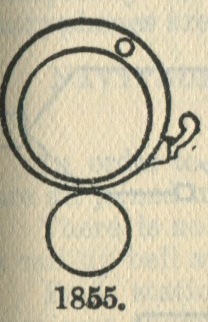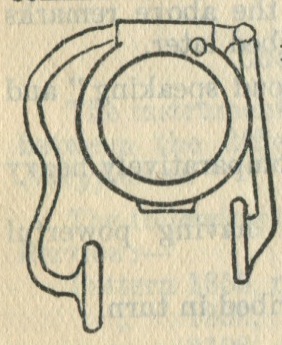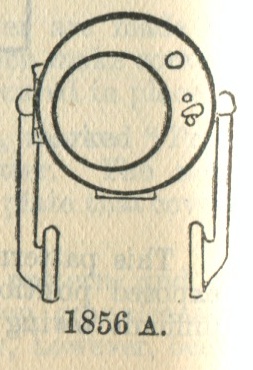Pattern 185X Navyphones: Difference between revisions
m (→Form Factor) |
m (→Form Factor) |
||
| (7 intermediate revisions by 2 users not shown) | |||
| Line 1: | Line 1: | ||
The Royal Navy's '''Pattern 1855''' (for upper deck use) and '''Pattern 1856''' (for engine room use) [[Navyphone]]s were created in 1902 for shipboard communication. | The Royal Navy's '''Pattern 1855''' (for upper deck use) and '''Pattern 1856''' (for engine room use) [[Navyphone]]s were created in 1902 for shipboard communication.{{ARTS1902|pp. 60-1 and Plate 25}} The original models were battery powered, though the 1856 was followed in 1907 by a '''Pattern 1856A''' which could be powered by motor generator.{{ARTS1907|p. 77 and Plate 11}} There was no Pattern 1855A navyphone; instead it seems that the [[Pattern 2140A]] was partnered with the 1856A. | ||
==Pattern 1855 Navyphone== | ==Pattern 1855 Navyphone== | ||
[[File:Pattern1855Navyphone_TDB1914.jpg|thumb| | [[File:Pattern1855Navyphone_TDB1914.jpg|thumb|300px|'''Pattern 1855 Navyphone'''{{TorpDB1914|p. 259}} <br> Presumably, the little circle at upper right is the call-up button, but this was actually located on the left side.{{INF}} ]] | ||
The pattern 1855 navyphone was essentially an intercom. It first saw use in 1902. | The pattern 1855 navyphone was essentially an intercom. It first saw use in 1902.{{ARTS1902|pp. 60-1 and Plate 25}} By a lack of contrary evidence, it appears that it was always wired directly to one other navyphone, possibly always a Pattern 1856 located in an engine room. | ||
===Form Factor=== | ===Form Factor=== | ||
The 1855 was bulkhead mounted in a cylindrical iron case, approximately 15cm across.<ref>estimating from ''Annual Report of the Torpedo School, 1902'', Plate 25.</ref> It had a push-to-talk lever marked ''Press whilst talking'' | The 1855 was bulkhead mounted in a cylindrical iron case, approximately 15cm across.<ref>estimating from ''Annual Report of the Torpedo School, 1902'', Plate 25.</ref> It had a push-to-talk lever marked ''Press whilst talking''{{ARTS1902|p. 60}} (or ''Press whilst speaking''{{TorpDB1914|p. 259}}) on the right side and a speaking transmitter on its face. Like many Graham navyphones, its speaker was inside and faced rearward; a metallic horn around 60mm at its mouth came out from beneath the chassis and projected the remote speaker's voice out to the local listener. | ||
A call-up button on the left side | A call-up button on the left side{{ARTS1902|p. 60}} sufficed to ring the bell at both the local and remote terminals. The bells and the battery were not an integral part of the navyphone. | ||
The Hunning cone-type transmitter was affixed by 3 screws and could be revolved (by rolling about its axis) | The Hunning cone-type transmitter was affixed by 3 screws and could be revolved (by rolling about its axis){{ElecDB1924|p. 275}} "to shake up the carbon granules."{{TorpDB1914|p. 260}} | ||
Like most navyphones before those used in ''Lord Nelson'', ''Bellerophon'' and later classes, these phones were powered in pairs off six pattern 1453 cells in a pattern 1704 battery box. | Like most navyphones before those used in ''Lord Nelson'', ''Bellerophon'' and later classes, these phones were powered in pairs off six pattern 1453 cells in a pattern 1704 battery box.{{TorpDB1914|p. 263}} | ||
===Service Life=== | ===Service Life=== | ||
It appears that the 1855 had no direct heirs to carry on the pattern number. The 1856A which followed its sister, however, is depicted working with a [[Pattern 2140A Navyphone]] in the 1907 Annual Report of the Torpedo School, suggesting this was the 1855's successor model.{{ARTS1907|Plate 11}} | |||
These phones were almost certainly obsolete by 1924, by which time only phones in the [[Pattern 246X Navyphones|2460]] and [[Pattern 333X Navyphones|3330]] series were in general use.{{ElecDB1924|p. 286}} | |||
These phones were almost certainly obsolete by 1924, by which time only phones in the [[Pattern 246X Navyphones | |||
==Pattern 1856 Navyphone== | ==Pattern 1856 Navyphone== | ||
[[File:Pattern1856Navyphone_TDB1914.jpg|thumb|300px|'''Pattern 1856 Navyphone'''<ref>''Torpedo Drill Book, 1914.'', p. 260</ref> <br>The small circle at the 1 o'clock position may be a call indicating lamp or the call-up push.{{INF}} ]] | |||
The 1856 was similar to the 1855, but specialised for use in the high-noise environment of an engine room and provides a great example of how comical some of the early navyphones could be. It was introduced in 1902 along with the 1855. | The 1856 was similar to the 1855, but specialised for use in the high-noise environment of an engine room and provides a great example of how comical some of the early navyphones could be. It was introduced in 1902 along with the 1855.{{ARTS1902|pp. 60-1 and Plate 25}} | ||
===Form Factor=== | ===Form Factor=== | ||
Like the 1855, the 1856 was bulkhead mounted in a cylindrical iron chassis, approximately 13cm across,<ref>estimating from ''Annual Report of the Torpedo School, 1903'', Plate 20.</ref> but it differed considerably in how one listened to its receiver. When the external call-up bell<ref>''Torpedo Drill Book, 1914'', p. 261.</ref> was hear to ring, someone would walk over and answer the call by swinging a rigid copper arm upward and outward through 90 degrees so he could place the rubber ear cup on its end over his ear. This action switched out the bell call-up circuit and activated the face-mounted transmitter and receivers. A second earpiece on a flexible copper tube could be cupped over his other ear to help isolate him from the noisy engineroom. | Like the 1855, the 1856 was bulkhead mounted in a cylindrical iron chassis, approximately 13cm across,<ref>estimating from ''Annual Report of the Torpedo School, 1903'', Plate 20.</ref> but it differed considerably in how one listened to its receiver. When the external call-up bell<ref>''Torpedo Drill Book, 1914'', p. 261.</ref> was hear to ring, someone would walk over and answer the call by swinging a rigid copper arm upward and outward through 90 degrees so he could place the rubber ear cup on its end over his ear. This action switched out the bell call-up circuit and activated the face-mounted transmitter and receivers. A second earpiece on a flexible copper tube could be cupped over his other ear to help isolate him from the noisy engineroom. | ||
The transmitter was affixed by 3 screws and could be revolved (by rolling about its axis)<ref>''Electrical Drill Book, 1924'', p. 275.</ref> "to shake up the carbon granules."<ref>''Torpedo Drill Book, 1914'', p. 260.</ref> | The transmitter was affixed by 3 screws and could be revolved (by rolling about its axis)<ref>''Electrical Drill Book, 1924'', p. 275.</ref> "to shake up the carbon granules."<ref>''Torpedo Drill Book, 1914'', p. 260.</ref> | ||
| Line 35: | Line 32: | ||
===Service Life=== | ===Service Life=== | ||
The 1856 was supplanted by the Pattern 1856A in 1907 as part of the move away from battery-powered navyphones.{{ARTS1907|pp. 76-7}} It is not clear whether existing installations were updated. | |||
The 1856 was supplanted by the Pattern 1856A in 1907 as part of the move away from battery-powered navyphones. | |||
==Pattern 1856A Navyphone== | ==Pattern 1856A Navyphone== | ||
[[File:Pattern1856ANavyphone_TDB1914.jpg|thumb|300px|'''Pattern 1856 Navyphone'''<ref>''Torpedo Drill Book, 1914.'', p. 266</ref> <br>The small circle at the 1 o'clock position may be a call indicating lamp or the call-up push.{{INF}} ]] | |||
The 1856A was an engine room navyphone introduced in 1907. | The 1856A was an engine room navyphone introduced in 1907.{{ARTS1907|pp. 76-7}} Primarily, it differed from the 1856 by being able to draw power from a motor generator supply rather than a battery. | ||
===Form Factor=== | ===Form Factor=== | ||
The 1856A was bulkhead mounted in a cylindrical iron chassis, approximately 13cm across.<ref>estimating from ''Annual Report of the Torpedo School, 1903'', Plate 20.</ref> When the external call-up bell<ref>''Torpedo Drill Book, 1914'', p. 261.</ref> was hear to ring, someone would walk over and answer the call by swinging a rigid copper arm upward and outward 90 degrees so he could place the rubber ear cup on its end over his ear. This action switched out the bell call-up circuit and activated the transmitter and receivers. A second earpiece on a flexible copper tube could be cupped over his other ear to help isolate him from the noisy engineroom. There was a call-up push button to ring the other end.<ref>''Torpedo Drill Book, 1914'', p. 268.</ref> | The 1856A was bulkhead mounted in a cylindrical iron chassis, approximately 13cm across.<ref>estimating from ''Annual Report of the Torpedo School, 1903'', Plate 20.</ref> When the external call-up bell<ref>''Torpedo Drill Book, 1914'', p. 261.</ref> was hear to ring, someone would walk over and answer the call by swinging a rigid copper arm upward and outward 90 degrees so he could place the rubber ear cup on its end over his ear. This action switched out the bell call-up circuit and activated the transmitter and receivers. A second earpiece on a flexible copper tube could be cupped over his other ear to help isolate him from the noisy engineroom. There was a call-up push button to ring the other end.<ref>''Torpedo Drill Book, 1914'', p. 268.</ref> | ||
The transmitter was affixed by 3 screws and could be revolved (by rolling about its axis)<ref>''Electrical Drill Book, 1924'', p. 275.</ref> "to shake up the carbon granules."<ref>''Torpedo Drill Book, 1914'', p. 260.</ref> | The transmitter was affixed by 3 screws and could be revolved (by rolling about its axis)<ref>''Electrical Drill Book, 1924'', p. 275.</ref> "to shake up the carbon granules."<ref>''Torpedo Drill Book, 1914'', p. 260.</ref> | ||
| Line 53: | Line 46: | ||
===Service Life=== | ===Service Life=== | ||
The ''Torpedo Drill Book, 1914'' lists the universal [[Pattern 2461 Navyphone]] as the successor to the 1856A.<ref>''Torpedo Drill Book, 1914'', p. 269.</ref> It is not certain whether existing installations were updated. | The ''Torpedo Drill Book, 1914'' lists the universal [[Pattern 2461 Navyphone]] as the successor to the 1856A.<ref>''Torpedo Drill Book, 1914'', p. 269.</ref> It is not certain whether existing installations were updated. | ||
| Line 65: | Line 57: | ||
==Bibliography== | ==Bibliography== | ||
{{refbegin}} | |||
*{{ | *{{TorpDB1914}} | ||
*{{ | *{{ARTS1902}} | ||
*{{ | *{{ARTS1903}} | ||
*{{ | *{{ARTS1907}} | ||
*{{ | *{{ElecDB1924}} | ||
{{refend}} | |||
[[Category:Communications Equipment]] | [[Category:Communications Equipment]] | ||
[[Category:Shipboard Equipment]] | [[Category:Shipboard Equipment]] | ||
Latest revision as of 20:11, 30 October 2012
The Royal Navy's Pattern 1855 (for upper deck use) and Pattern 1856 (for engine room use) Navyphones were created in 1902 for shipboard communication.[1] The original models were battery powered, though the 1856 was followed in 1907 by a Pattern 1856A which could be powered by motor generator.[2] There was no Pattern 1855A navyphone; instead it seems that the Pattern 2140A was partnered with the 1856A.

Presumably, the little circle at upper right is the call-up button, but this was actually located on the left side.[Inference]
The pattern 1855 navyphone was essentially an intercom. It first saw use in 1902.[4] By a lack of contrary evidence, it appears that it was always wired directly to one other navyphone, possibly always a Pattern 1856 located in an engine room.
Form Factor
The 1855 was bulkhead mounted in a cylindrical iron case, approximately 15cm across.[5] It had a push-to-talk lever marked Press whilst talking[6] (or Press whilst speaking[7]) on the right side and a speaking transmitter on its face. Like many Graham navyphones, its speaker was inside and faced rearward; a metallic horn around 60mm at its mouth came out from beneath the chassis and projected the remote speaker's voice out to the local listener.
A call-up button on the left side[8] sufficed to ring the bell at both the local and remote terminals. The bells and the battery were not an integral part of the navyphone.
The Hunning cone-type transmitter was affixed by 3 screws and could be revolved (by rolling about its axis)[9] "to shake up the carbon granules."[10]
Like most navyphones before those used in Lord Nelson, Bellerophon and later classes, these phones were powered in pairs off six pattern 1453 cells in a pattern 1704 battery box.[11]
Service Life
It appears that the 1855 had no direct heirs to carry on the pattern number. The 1856A which followed its sister, however, is depicted working with a Pattern 2140A Navyphone in the 1907 Annual Report of the Torpedo School, suggesting this was the 1855's successor model.[12]
These phones were almost certainly obsolete by 1924, by which time only phones in the 2460 and 3330 series were in general use.[13]

The small circle at the 1 o'clock position may be a call indicating lamp or the call-up push.[Inference]
The 1856 was similar to the 1855, but specialised for use in the high-noise environment of an engine room and provides a great example of how comical some of the early navyphones could be. It was introduced in 1902 along with the 1855.[15]
Form Factor
Like the 1855, the 1856 was bulkhead mounted in a cylindrical iron chassis, approximately 13cm across,[16] but it differed considerably in how one listened to its receiver. When the external call-up bell[17] was hear to ring, someone would walk over and answer the call by swinging a rigid copper arm upward and outward through 90 degrees so he could place the rubber ear cup on its end over his ear. This action switched out the bell call-up circuit and activated the face-mounted transmitter and receivers. A second earpiece on a flexible copper tube could be cupped over his other ear to help isolate him from the noisy engineroom.
The transmitter was affixed by 3 screws and could be revolved (by rolling about its axis)[18] "to shake up the carbon granules."[19]
Like most navyphones before those used in Lord Nelson, Bellerophon and later classes, these phones were probably battery-powered, initially, powered in pairs off six pattern 1453 cells in a pattern 1704 battery box.[20] This box was separate.
Service Life
The 1856 was supplanted by the Pattern 1856A in 1907 as part of the move away from battery-powered navyphones.[21] It is not clear whether existing installations were updated.

The small circle at the 1 o'clock position may be a call indicating lamp or the call-up push.[Inference]
The 1856A was an engine room navyphone introduced in 1907.[23] Primarily, it differed from the 1856 by being able to draw power from a motor generator supply rather than a battery.
Form Factor
The 1856A was bulkhead mounted in a cylindrical iron chassis, approximately 13cm across.[24] When the external call-up bell[25] was hear to ring, someone would walk over and answer the call by swinging a rigid copper arm upward and outward 90 degrees so he could place the rubber ear cup on its end over his ear. This action switched out the bell call-up circuit and activated the transmitter and receivers. A second earpiece on a flexible copper tube could be cupped over his other ear to help isolate him from the noisy engineroom. There was a call-up push button to ring the other end.[26]
The transmitter was affixed by 3 screws and could be revolved (by rolling about its axis)[27] "to shake up the carbon granules."[28]
Like most navyphones before those used in Lord Nelson, Bellerophon and later classes, these phones were probably battery-powered, initially, powered in pairs off six pattern 1453 cells in a pattern 1704 battery box.[29] This box was separate.
Service Life
The Torpedo Drill Book, 1914 lists the universal Pattern 2461 Navyphone as the successor to the 1856A.[30] It is not certain whether existing installations were updated.
See Also
- Navyphone
- Pattern 2140A Navyphone (successor to Pattern 1855)
- Pattern 2461 Navyphone (successor to Pattern 1856A)
Footnotes
- ↑ Annual Report of the Torpedo School, 1902. pp. 60-1 and Plate 25.
- ↑ Annual Report of the Torpedo School, 1907. p. 77 and Plate 11.
- ↑ Torpedo Drill Book, 1914. p. 259.
- ↑ Annual Report of the Torpedo School, 1902. pp. 60-1 and Plate 25.
- ↑ estimating from Annual Report of the Torpedo School, 1902, Plate 25.
- ↑ Annual Report of the Torpedo School, 1902. p. 60.
- ↑ Torpedo Drill Book, 1914. p. 259.
- ↑ Annual Report of the Torpedo School, 1902. p. 60.
- ↑ Electrical Drill Book, 1924. p. 275.
- ↑ Torpedo Drill Book, 1914. p. 260.
- ↑ Torpedo Drill Book, 1914. p. 263.
- ↑ Annual Report of the Torpedo School, 1907. Plate 11.
- ↑ Electrical Drill Book, 1924. p. 286.
- ↑ Torpedo Drill Book, 1914., p. 260
- ↑ Annual Report of the Torpedo School, 1902. pp. 60-1 and Plate 25.
- ↑ estimating from Annual Report of the Torpedo School, 1903, Plate 20.
- ↑ Torpedo Drill Book, 1914, p. 261.
- ↑ Electrical Drill Book, 1924, p. 275.
- ↑ Torpedo Drill Book, 1914, p. 260.
- ↑ Torpedo Drill Book, 1914, p. 263.
- ↑ Annual Report of the Torpedo School, 1907. pp. 76-7.
- ↑ Torpedo Drill Book, 1914., p. 266
- ↑ Annual Report of the Torpedo School, 1907. pp. 76-7.
- ↑ estimating from Annual Report of the Torpedo School, 1903, Plate 20.
- ↑ Torpedo Drill Book, 1914, p. 261.
- ↑ Torpedo Drill Book, 1914, p. 268.
- ↑ Electrical Drill Book, 1924, p. 275.
- ↑ Torpedo Drill Book, 1914, p. 260.
- ↑ Torpedo Drill Book, 1914, p. 263.
- ↑ Torpedo Drill Book, 1914, p. 269.
Bibliography
- H.M.S.O., London (1914). Torpedo Drill Book, 1914 (Corrected to May 15) Copy in Tony Lovell's library.
- H.M.S. Vernon. Annual Report of the Torpedo School, 1902. Copy 268 at The National Archives. ADM 189/22.
- H.M.S. Vernon. Annual Report of the Torpedo School, 1903, with Appendix (Wireless Telegraphy). Copy 478 at The National Archives. ADM 189/23.
- H.M.S. Vernon. Annual Report of the Torpedo School, 1907, with Appendix (Wireless Telegraphy). Copy 9 at The National Archives. ADM 189/27.
- D.T.M. Department, Admiralty (1924). Electrical Drill Book. O.U. 5317. Copy in Tony Lovell's library.